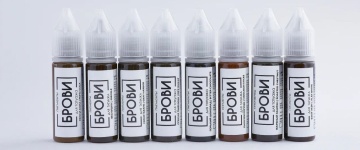Metabolism of Permanent Makeup Pigments
All pigments are metabolized in the skin in different ways. This is influenced by many factors: the physicochemical properties of pigments, their interaction with light and metabolic processes in the body. It is hypothesized that tattoo and PMU pigments remain in the skin because the pigment particles are insoluble and too large to be transported by cells of the immune system.
On the other hand, some pigments have photostability — the ability of a substance to retain its properties when interacting with light. They are decomposed by sunlight, change their chemical structure and lose their color.
Effect of Laser on Pigments
A laser is the same source of electromagnetic radiation as sunlight, and it has a strictly defined radiation wavelength (monochromaticity). This property is used to influence the particles of pigments that can absorb a certain wavelength characteristic of their color.
For the laser, the chemical nature of the pigment does not matter. Only the ability of a substance to absorb light of a certain wavelength matters. Whether you treat a red tattoo or a tomato, the process will be the same—the wave absorption.
Laser Absorption by Different Colors of Pigments
The properties of black pigments are such that they absorb all wavelengths, especially infrared ones. Therefore, a 1064 nm wave is used to remove them.
Red pigments absorb well wavelengths of about 500 nm—green light. Therefore, we use a wavelength of 532 nm.
Green pigments absorb 750 nm — red light.
Yellow pigments absorb 400 nm — violet and ultraviolet light. It is possible to create lasers with such a wavelength, and they do exist. But human skin blocks such radiation, and it is not possible to influence pigment particles in this way.
White pigments do not absorb any light. The laser is powerless against them.
Natural Removal of Pigments from the Body
It contains much less material. Over time, the bonds between the particles are destroyed, the particles become available to the cells of the immune system, and a certain amount of pigment particles is indeed gradually eliminated from the body. But it is impossible to say that pigments will disappear from the skin by 100%. Some of them are permanently integrated into the cellular structure.
The ink consists of particles of different colors, differing in chemical structure and quantitative ratio. Obviously, those pigments less present in the composition will disappear faster. In addition, pigments differ in bioavailability — the ability to be metabolized by the immune system. This property depends on the particle size and characteristics of the binders.
To fully understand this aspect, you need to study histology. A lot depends on the skin. In our opinion, the quality of the result and the life expectancy of PMU depends even more on the skin of a particular person than on ink.
These are just iron facts and physics, nothing can be done about it.
4 Videos About Laser Pigment Removal From BROVI
We can talk a lot about lasers ad infinitum, but at the time of writing this article, we'd already had 4 episodes on our YouTube channel about removing BROVI inks.
Comprehensive information, confirmed in practice. Watch it.





